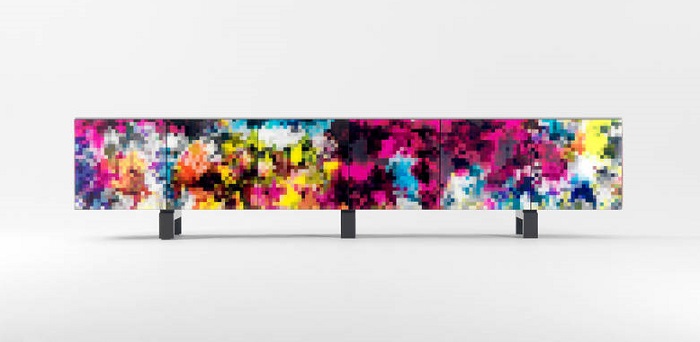
Dreams cabinet, Cristian Zuzunaga, BD Barcelona, Spain, 2015.
Cristian Zuzunaga's Dreams sideboard/credenza in Switch Modern's Atlanta showroom has been a visual catalyst for prompting a number of conversations about what actually constitutes concealed storage and what functions as sculpture... are these sentiments mutually exclusive? We think not.
What is a sideboard? Historically, its function has been as a cabinet that is typically placed within a dining room. Early examples were simple rectilinear forms for storage that included an expansive horizontal surface providing a place for presenting and preparing food - pragmatically, this surface was often composed of stone that would function like a trivet for hot dishes and pots. By the late Middle Ages, this expanse had also started to do double-duty as a surface for displaying decorative plates and vessels.
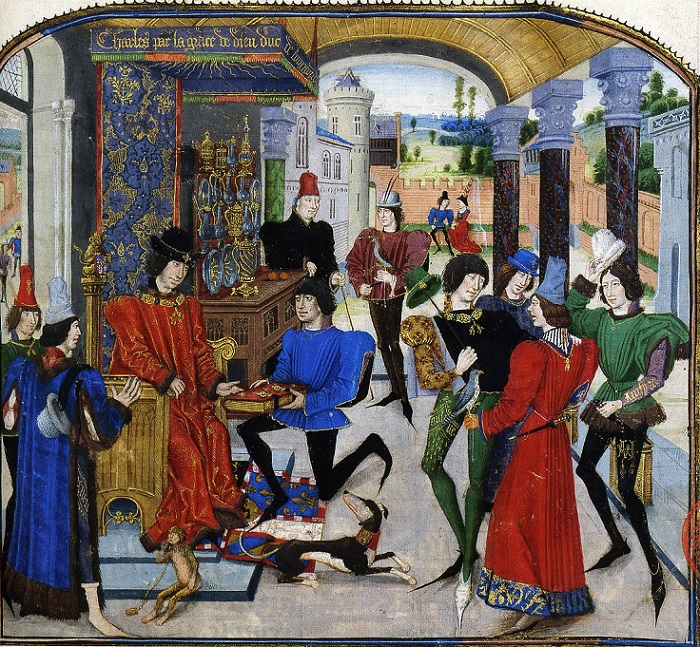
This illuminated manuscript from the mid 15th century illustrates a sideboard being used as a surface as well as for presenting decorative objects like vessels and plates. As the sideboard's function was changing, so was the way in which the surfaces of its form were both treated and expressed. By the Renaissance, the sideboard had become a vehicle for elaborate and ornately carved exterior decoration.
Fast forward to the 20th century throughout which the sideboard or credenza form mirrored the numerous salient styles of modernism and was now also rendered in a number of materials other than wood - Bauhaus tubular steel from the 1920s, exuberant yet streamlined Art Deco patterned veneers from the 1930s, clean lines and forms by midcentury, new materials like plastic and lucite in the 1960s and 1970s, and the enigmatic composite forms and patterned laminates associated with the Memphis movement in the 1980s. It was at this point that the sideboard's visually expressed form began to overtly blur the lines between functional storage repository and sculpture.

Composite photo illustrating various sideboards throughout the 20th century. Clockwise from the left: Art Deco sideboard from the 1930s; Florence Knoll's midcentury credenza with marble top from the early 1960s; Raymond Loewy's DF-2000 cabinet with space-age plastic veneered doors from the late 1960s; Tartar sideboard designed by Ettore Sottsass in the 1980s for Memphis.
As with its 20th century precedents, sideboard design in the 21st century continues to challenge preconceived notions of both the function and aesthetics of this time-honored typology. In order to better illustrate this range of "sideboard as sculpture," we've included Dreams along with three other contemporary sideboard designs produced by Spanish manufacturer, BD Barcelona. Designs by Jaime Hayon (Showtime Multileg, 2006), Antoine + Manuel (Tout Va Bien, 2009), and Doshi Levien (Shanty, 2014) all meet the functional expectations of a sideboard or credenza, yet each has been infused with a range of unexpected and engaging aesthetics.
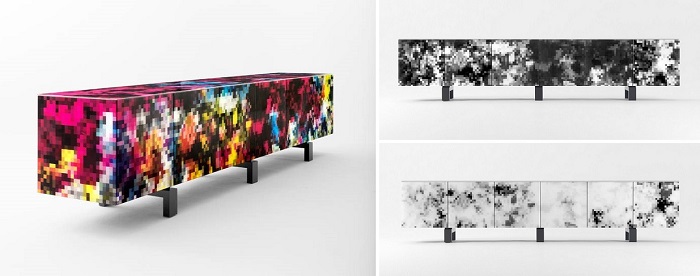
The Dreams sideboard/credenza sports a pixelated, digital age aesthetic available in color as well as monochromatic, grayscale versions with black or white as the ascendant colorway.
Dreams does function masterfully as a sideboard/credenza by providing both concealed storage and an expansive horizontal surface, yet it also functions as a highly aesthetic object - indeed, much like a sculpture. Its front doors, sides, and surface expanse all sport an integrated tempered glass veneer that has been screen-printed with an exuberant geometric arrangement of exaggerated multi-color pixels. It's also available in a monochromatic, grayscale version... either quite literally denotes a digital age aesthetic.
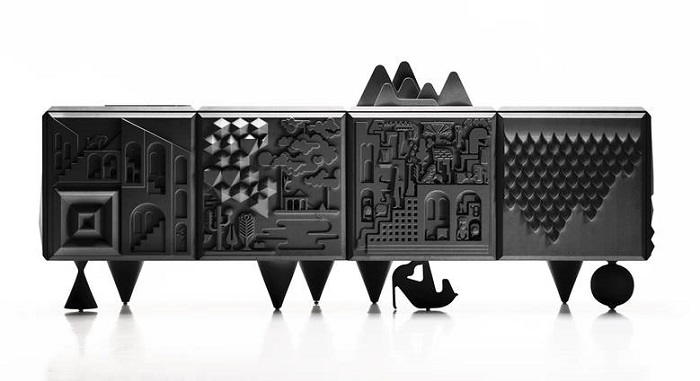
Tout Va Bien, Antoine + Manuel, BD Barcelona, 2009. Illustrated here as a long, horizontally-oriented sideboard; the design can also be configured as a small two-door cabinet. There is wonderful flexibility in customizing the design through panel selection and respective order as well as the combination and arrangement of the sideboard's sculptural legs.
The much-celebrated French artist duo of Antoine + Manuel (Antoine Audiau and Manuel Warosz) met in Paris while attending art school and have developed a unique graphic style that combines hand drawing, computer illustration, photography, and typography. They created their first piece of furniture, Tout Va Bien (quite literally translated from French as "all is well"), in 2009 for BD Barcelona. Akin to some of the decorative credenzas from the 15th century, the artists have created a visual narrative that is presented within various levels of relief on the side and door panels - even one of the top panels. While channeling the relief aesthetic of ancient, medieval, and Renaissance art, Antoine + Manuel have imbued these with a profoundly engaging and enigmatic iconography.
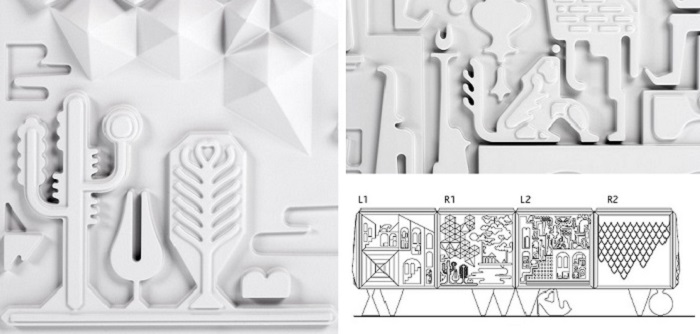
Composite photo illustrating door details from Antoine + Manuel's Tout Va Bien. A viewer literally sees something new from virtually every angle of this piece - truncated pyramids in various depths, complex architecture with an unexpected abstracted cat or dog waiting near a door, schematic landscapes that include clouds and even a cactus - one discovers something new every time. The reliefs have been organized within a rectilinear form and homogenized into a single monochromatic color of black or white akin to a Louise Nevelson Constructivist sculpture.

Tout Va Bien is also available as a vertically-oriented cabinet; either version is available in a choice of black or white finish. The intricate compositions for the doors and side panels are composed of injection-molded polyurethane that has been combined with a wood substrate.
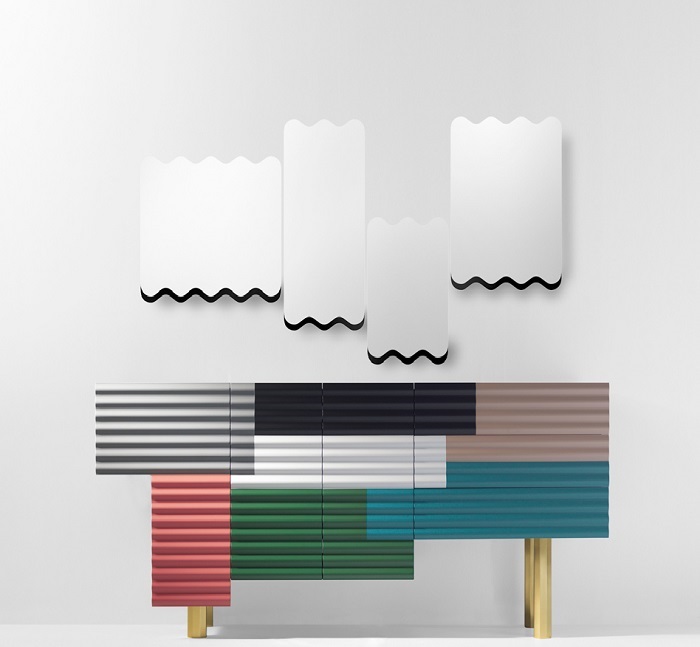
Shanty, Doshi Levien, BD Barcelona, 2014. Illustrated here with a matching wall-mounted modular mirror system that mimics the outline of Shanty's undulating façade.
Doshi Levien's Shanty for BD Barcelona was imagined as a patchwork of corrugated surfaces that reference the ephemeral "shanty" dwellings from Brazil, Africa, and India. Shanty celebrates the inherent structural beauty of these seemingly temporary constructions. The credenza's corrugated façade is presented as a composition of different colored surfaces that conceals a carefully considered storage volume. The form itself is asymmetric and every door opens in a distinct way. The Shanty collection is available in several different versions and finishes creating colorful or monochromatic combinations. The sideboard can also be presented with a wall-mounted mirror system that allows for different compositions and mimics the outline of Shanty's form.
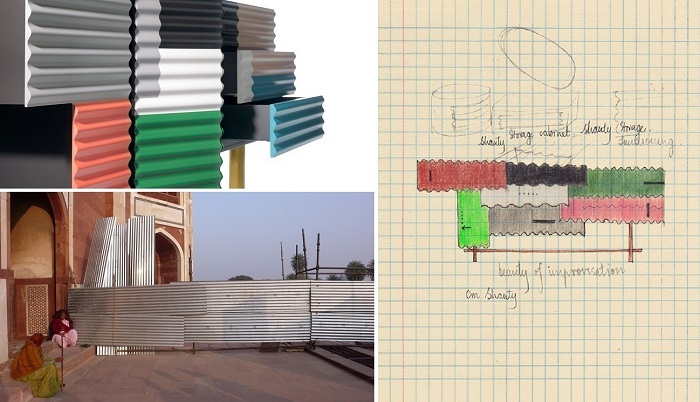
Clockwise from left: Detail of the distinct ways in which Shanty's drawers and doors open; designers' color-blocked sketch of Shanty; urban landscape with the ubiquitous corrugated metal that was the inspiration for Doshi Levien's Shanty design for BD Barcelona.

Showtime Multileg sideboard, Jaime Hayon, BD Barcelona, 2006. Available as a modular two-door container with four legs, Showtime can be configured in several lengths as well as a vertically-oriented cabinet. As part of configuring the sideboard, the user may also select the combination and arrangement of underside supports from a choice of twelve different leg styles as illustrated in this six-door Showtime Multileg sideboard.
With Jaime Hayon's Showtime Multileg sideboard, it's truly all about the legs. Each underside vertical support (several are variations on a thick spindle) are all different from each other - when presented together, they create a visual symphony of ornate volume that collectively supports a minimalist, rectilinear container. Showtime is available in several horizontal lengths as well as a vertically-oriented cabinet. Since its introduction, Showtime Multileg has been available in several lacquer finishes as well as walnut; the sideboard's top has options that include glass and marble.
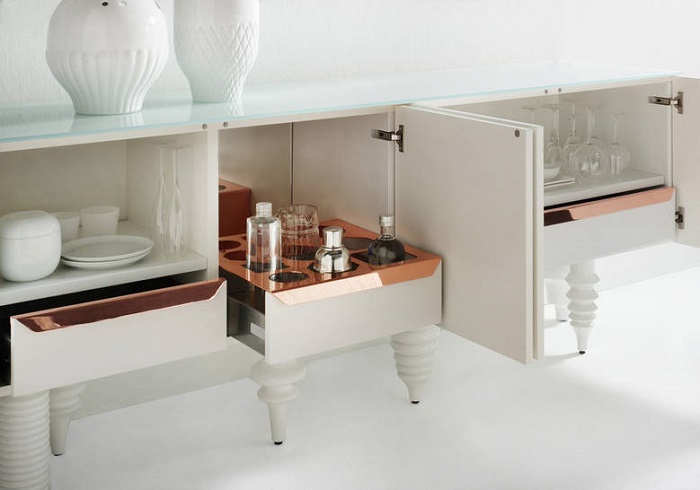
Showtime can be configured internally with shelves and drawers including those with specialized functions like this bottle repository.
All of the aforementioned sideboards not only function beautifully as concealed storage cabinets, each also functions as an uber-aesthetic, visually engaging object - instantly becoming the focal point of any interior in which it is placed. Most also provide a high level of customization that allows the user to determine the resulting aesthetic and function through their respective personalization of the available options. Please drop by Switch Modern's Atlanta showroom to experience the Dreams credenza firsthand or contact us at info@switchmodern.com or 404-605-0196 about exploring the numerous examples of "storage as sculpture" that are available through BD Barcelona as well as a number of other manufacturers that Switch Modern represents.